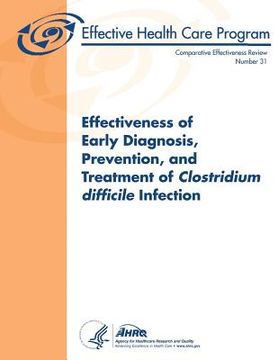Effectiveness of Early Diagnosis, Prevention, and Treatment of Clostridium difficile Infection: Comparative Effectiveness Review Number 31 (en Inglés)
Reseña del libro "Effectiveness of Early Diagnosis, Prevention, and Treatment of Clostridium difficile Infection: Comparative Effectiveness Review Number 31 (en Inglés)"
Clostridium difficile infection (CDI) is a serious healthcare-associated infection and a growing health care problem. C. difficile is a Gram-positive, spore-forming, anaerobic bacterium that, when ingested, can cause CDI if it is a toxigenic strain. CDI symptoms include varying levels of diarrhea severity, as well as pseudomembranous colitis and toxic megacolon. CDI incidence is estimated at 6.5 cases per 10,000 patient days in hospital. About 250,000 hospitalizations were associated with CDI in 2005. Direct attributable mortality from CDI has been reported to be as high as 6.9 % of cases. Elderly people in hospitals account for the vast majority of severe morbidity and mortality. Residents of long-term care facilities are also at higher risk. Incidence rates may increase by fourfold or fivefold during outbreaks. In addition to institutional care environments, C. difficile is also common in the community, being easily isolated from soil and water samples. Community-associated CDI rates are generally much lower, accounting for 27 % of all CDI cases in a recent prevalence study, but are also on the rise. However, the source of the C. difficile organisms responsible for cases of CDI in the community is not well understood. In order for CDI to develop, a person must be infected with a strain of C. difficile capable of making toxin in the person's colon. Approximately 1-2 % of healthy individuals are colonized with C. difficile. If these people have usual, healthy colonic flora, the risk of CDI is very low. There is a small risk of CDI if the colon flora becomes disturbed, commonly through antibiotic use, while the person is colonized with a toxigenic strain. Antibiotics that disturb colon flora enough to allow CDI to develop must get into the colon, and they are associated with alterations in relative amounts of colon bacterial constituents. The immune status of the patient also contributes to the risk of developing CDI and the experienced severity. Other risk factors include increasing age, female gender, comorbidities, gastrointestinal procedures, and use of gastric acid suppression medications. Risk profiles for recurrent CDI are similar. One study, which statistically modeled CDI within the hospital setting, suggested that reducing patient susceptibility to infection is more effective in reducing CDI cases than lowering transmission rates. The purpose of this systematic review was to provide an overarching assessment of the evidence for comparing the accuracy of diagnostic tests and the effectiveness of prevention and treatment interventions on initial and recurrent CDI-related patient outcomes in adult patients. The major impetus of this review is the presence of clinical disease, not asymptomatic carriage of the C. difficile organism. The review focuses on adult patients because adults, and particularly elderly adults, carry the large majority of the morbidity and mortality burden. The following Key Questions (KQs) form the basis for this review: KQ 1. How do different methods for detection of toxigenic C. difficile to assist with diagnosis of CDI compare in their sensitivity and specificity? Do the differences in performance measures vary with sample characteristics? KQ 2. What are effective prevention strategies? What is the effectiveness of current prevention strategies? What are the harms associated with prevention strategies? How sustainable are prevention practices in health care (outpatient, hospital inpatient, extended care) and community settings? KQ 3. What are the comparative effectiveness and harms of different antibiotic treatments? Does effectiveness vary by disease severity or strain? Does effectiveness vary by patient characteristics: age, gender, comorbidity, hospital- versus community-acquired setting? How do prevention and treatment of CDI affect resistance of other pathogens? KQ 4. What are the effectiveness and harms of nonstandard adjunctive interventions? In patients with relapse/recurrent CDI?

